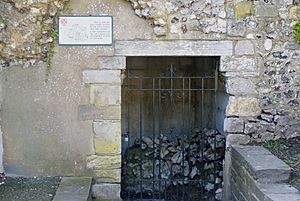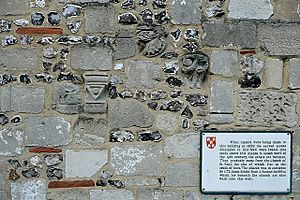Venta Belgarum facts for kids
Venta Belgarum was an important town in the Roman province of Britannia Superior, which was a part of Roman Britain. It was the main city, or civitas capital, for a local tribe called the Belgae. Over time, this Roman town grew and changed into the modern city we know today as Winchester.
What's in a Name?
The name Venta comes from an old Celtic word, *Uentā, which simply means "market." The Romans added "Belgarum" to the name, making it Venta Belgarum. This meant "the market of the Belgae tribe." They did this to tell it apart from other Roman towns in Britain that also had "Venta" in their names, like Venta Silurum and Venta Icenorum.
Gods and Temples
In the center of Venta Belgarum, there was a large public area called a forum and a big building called a basilica. It seems this building had a temple inside dedicated to three important Roman gods: Jupiter, Juno, and Minerva. There was also a special pillar nearby, called a Jupiter Column.
Outside the main forum area, there was another temple built in a Romano-British style. This temple was for Epona, a Celtic goddess linked to horses.
The people of Venta Belgarum buried their dead in large cemeteries. One big cemetery was to the north of the town, at a place called Lankhills. Another was to the east. Archaeologists, like Julian Richards, have studied these cemeteries. They dug there in 1998 and again in 2013 for a BBC TV show called Meet the Ancestors. These digs helped us learn a lot about the people who lived in Venta Belgarum.
The Town Changes Over Time
Around the middle of the 4th century AD, new building projects in Venta Belgarum stopped. Some houses started to fall apart, and the town's water drainage system didn't work as well. People began to move to higher, drier parts of the town.
However, the town's defenses, like its walls, were made stronger. The cemeteries continued to be used, and some men buried there wore belts that looked like military belts. This suggests they might have been soldiers or guards. A historian named David Nash Ford believes Venta Belgarum is the "Fort Venta" (or Cair Guinntguic) mentioned by an old writer named Nennius in his book History of the Britains. Nennius listed it as one of the 28 important cities in Britain after the Romans left.
After the Roman withdrawal from Britain in 410 AD, city life in Venta Belgarum seemed to stop around 450 AD. However, a small administrative center, perhaps a place where leaders met, might have continued in the spot where the later Anglo-Saxon palace was built.
During the time of the Saxon invasions of Britain, new settlements began to appear. Cemeteries from the 6th and 7th centuries show that people were living there again. The town, now called Wintanceastre, became a very important place. It was often the home base for the kings of Wessex, and later for other Saxon, Danish, and Norman kings of England.



